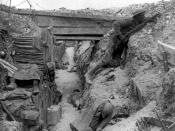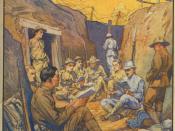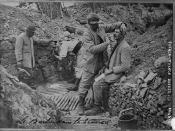THE NATURE OF WORLD WAR 1
'The military mind always imagines that the next war will be on the same lines as the last. That has never been the case and never will be.' (Foch, 1926)
No one had expected the First World War to become the "War to end all wars" as it was hailed at its conclusion. The general consensus in early 1914 was that it would all be over by Christmas of that year. This prediction, however, could not have been more flawed. The introduction of modernised battle techniques and strategies such as trench warfare, the use of poison gas, and machine guns meant that the ideologies, concepts and tactical approaches to war had been radically altered from warfare in the past. Consequently, these technological advances had brought more bloodshed, destruction and immense human cost than any event in the history of mankind. Instead of a swift, decisive victories or defeats, the battles on every front stagnated into trench warfare, neither side able to penetrate the defensive barrages of the other.
World War One lasted until November 1918, and through its course caused colossal damage to many counties economically, socially and politically. By the time it was over, the unanimous opinion around the world was a resounding 'never again'.
A dangerous tactic that evolved during World War 1 was the use of poisonous gases. Various gases were put to use during The First World War 1 including the likes of asphyxiating (suffocating), lachrymatory (causes weeping) and vesicant (blistering) gas. One of the more widely used gases was the mustard gas which when used by the Germans in 1917 caused 20 000 British casualties in 6 weeks.
The gases could be delivered in two ways. One method was for the gas to be released from a...



World War I
You have written a good essay about the horrors of trench warfare and the gruesome misery that was the lot of the World War I soldier. When I read your discussion of death by poison gas and machine gun fire, I thought of one of the most famous poems written in "The Great War." For some idea of how ghastly it was to die from a gas attack, I recommend the poem "Dulce et Decorum Est" by the famed British officer Wilfred Owen who died of machine gun fire at the age of 25. It's hardly bland.
9 out of 9 people found this comment useful.